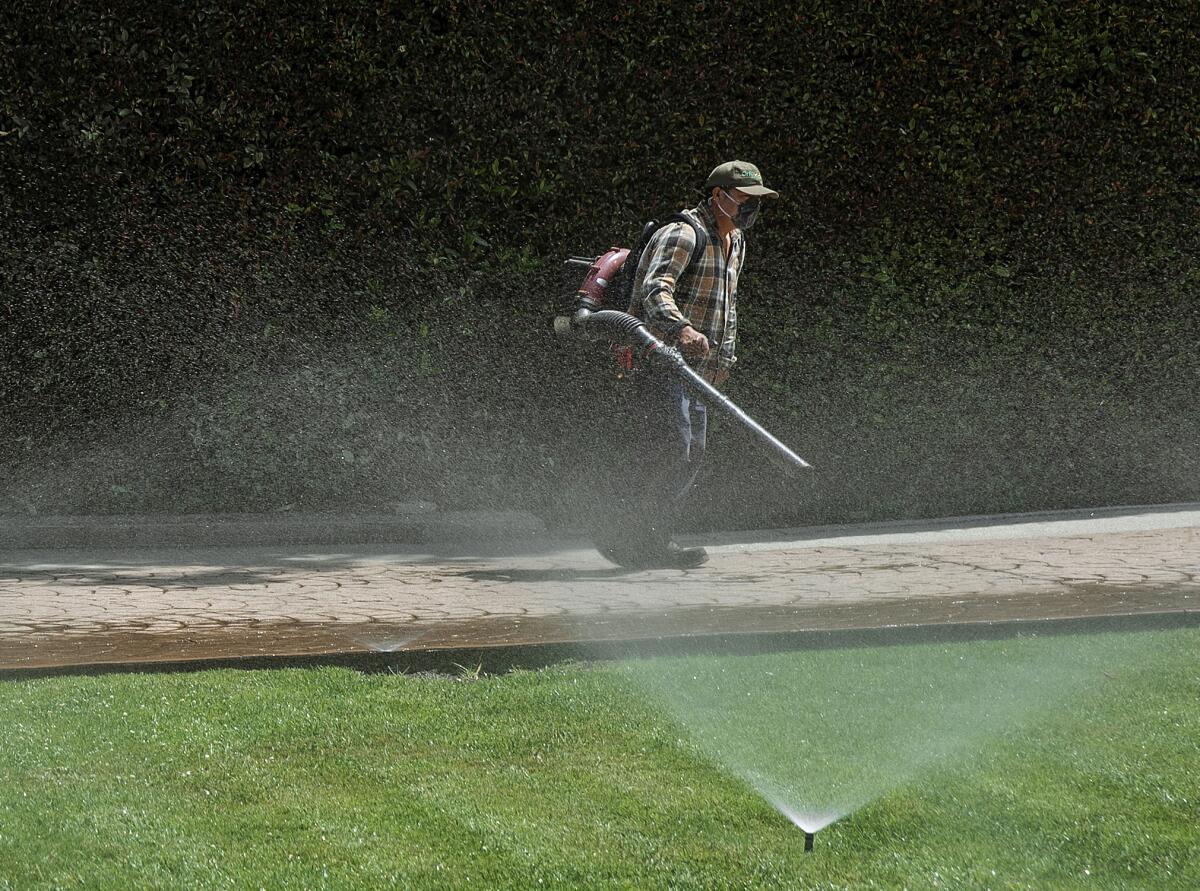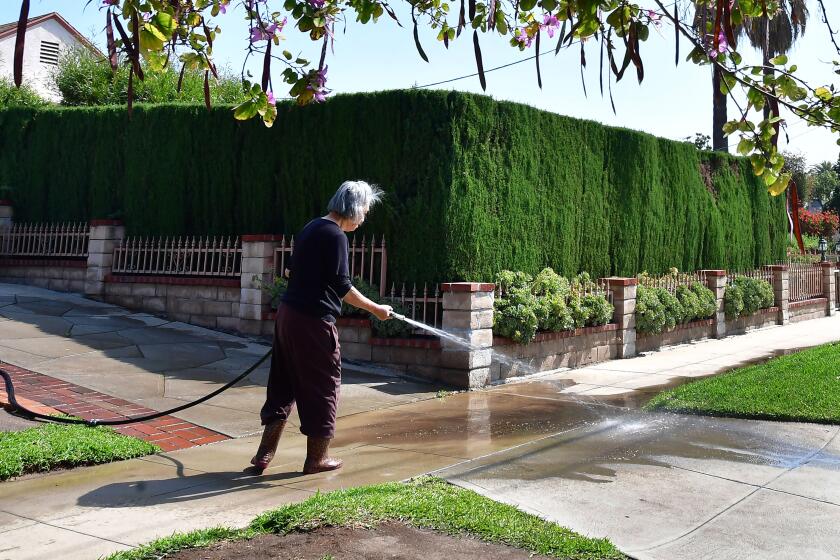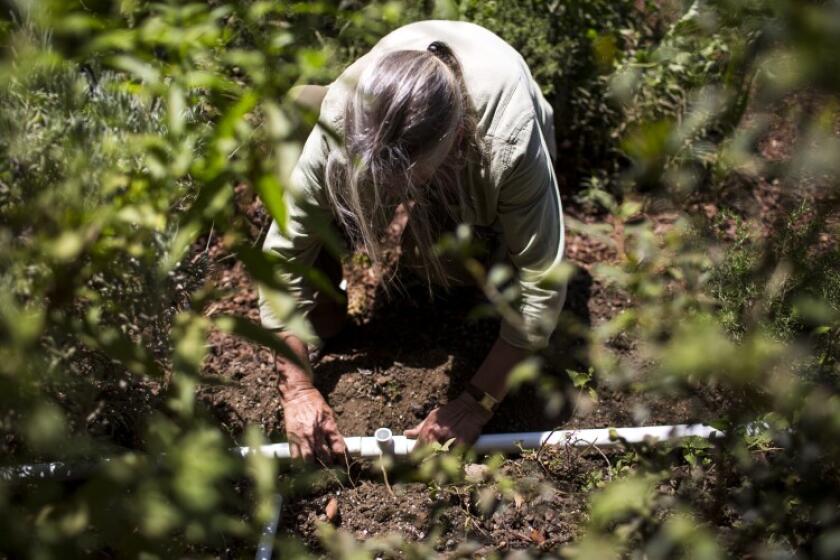California’s water conservation has been a bust so far. Will drought restrictions work?

- Share via
Almost a year after Gov. Gavin Newsom pleaded with Californians to voluntarily cut their water use by 15% amid a worsening drought, water conservation figures are still nowhere near that mark.
Now, as millions across Southern California face unprecedented water restrictions beginning next month, some water experts say that much broader cuts, such as those ordered by former Gov. Jerry Brown during the last drought, are needed to rouse the state from its false sense of water security.
“Even during the last drought, when Gov. Brown asked for voluntary cuts, we didn’t meet those,” said Heather Cooley, director of research at the Pacific Institute, a water think tank in Oakland. “We really need to go toward the mandatory. It really does send a signal that we are all in this together, and that everyone needs to be doing their part.”
Between July — when Newsom urged Californians to slash water use by 15% — and February, statewide cumulative water savings have amounted to just 5.8% relative to a 2020 baseline.
Large portions of Southern California are being told to water outdoors just one day a week. And a total watering ban could be imposed by fall.
Water districts in Northern California, which began experiencing severe shortages last year, have done the most to conserve. The Marin Municipal Water District cut use by 28.5% after local reservoirs began to run dry, forcing the water supplier to move to Stage 4 of its drought contingency plan.
The North Coast region also reduced water usage by 14.5% and the San Francisco Bay region by 10.5%.
But in Southern California, which had ample reserves last year, the story has been very different. In the South Coast hydrologic region, which is home to more than half the state’s population, water use dropped by just 4.6% in the same period, and the Los Angeles Department of Water and Power saw just 2.6% cumulative savings.
A few water districts even increased their water usage significantly, with El Segundo reporting 44.6% more water since last July.
El Segundo officials say that increase was tied to the disastrous flooding of L.A.’s Hyperion Water Reclamation Plant in July. After debris clogged filtering screens at the Playa del Rey plant, industrial customers that usually used recycled water for cooling had to use potable water for several months, said Elias Sassoon, El Segundo’s director of public works.
After California experienced its driest ever January, February and March, leaving State Water Project supplies perilously low, officials with the Metropolitan Water District of Southern California declared unprecedented restrictions that are set to begin next month. Though Cooley said the action may serve as a “wake-up call” for many, it still remains to be seen whether the state can change course.
Experts have offered a variety of reasons for California’s lackluster conservation efforts.
Some point to the drier-than-usual climate, which caused Californians to water their lawns and gardens more often than usual at the start of the year.
Cooley and others say the lack of statewide mandatory restrictions on water use, such as those ordered by Brown two years into the last drought, is to blame.
Still others say there’s a psychological aspect that comes with dealing with drought for an extended period of time.
“We’ve been talking about drought for a really long time at this point, even though we had like a brief little lapse,” said Kelly Sanders, a professor of environmental engineering at USC Viterbi School of Engineering. People are “becoming desensitized to the severity of the drought. You don’t hear people talking about it quite as much as you did in 2015 and 2016.”
The possibility of your water being shut off is also “less tangible” than something like having your electricity going out, Sanders said.
The water that cleans your clothes isn’t safe to drink, but it could be good for your plants. Here’s how to use grey water amid drought restrictions.
Still, the experts insist a 15% statewide goal is achievable.
There remain many opportunities to reduce long-term water use, such as replacing old appliances that use significantly more water than ones on the market now, Cooley said.
The Pacific Institute’s research found that urban water use could be decreased by an additional 30% just by adopting current standards for appliance water efficiency. This includes fixing leaky pipes and replacing washing machines and toilets.
Further investment in what is considered more “leading-edge technology” could increase water savings to 48%, Cooley said.
Officials are also targeting lawns as one of the biggest culprits of unnecessary water use.
The State Water Resources Control Board is considering a ban on the irrigation of turf on industrial, commercial and institutional properties like schools and hospitals, “where that turf is not serving a functional purpose,” said James Nachbaur, director of research, planning and performance at the state water conservation agency.
This would not affect individual homeowners, parks or other areas where people are actively using the turf, Nachbaur said.
Many water suppliers around the state also offer various rebates for replacing lawns with drought-tolerant gardens or standard sprinkler systems with drip irrigation, which use 20% to 50% less water than sprinklers. The Los Angeles Department of Water and Power has offered a $3.00 rebate per square foot of turf for up to 5,000 square feet since 2019.
Changing a landscape is still a “relatively easier way” to become more efficient in our water use than tackling indoor water use, which has already been dropping over time in California and continues to decline, Nachbaur said.
Despite the slow progress in water conservation so far, Nachbaur believes the actions by the water board and local suppliers as well as ramped-up messaging campaigns build on each other and are “adding up to more cumulative awareness of drought.”
The MWD approved a nearly $11-million media campaign in hopes of capturing people’s attention amid a “dizzying” news cycle, according to the board’s chief operating officer, Deven Upadhyay.
There’s a cultural resistance, however, to these kinds of changes, experts say. The verdant lawns and expansive yards are certainly an object of American obsession, a trademark of homeownership and the subject of inspection by homeowners associations, nosy neighbors and the like.
“For a very, very long time, we’ve kind of told everybody that you can have whatever kinds of plants that you want,” Sanders said. “We’re just going to have to get used to a landscape that looks a little bit more native to Southern California and its current climate, you know. The times of big lush green lawns might be limited.”
Times staff writer Hayley Smith contributed to this report.









